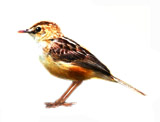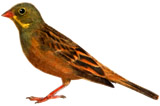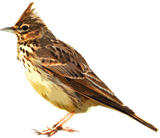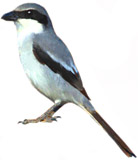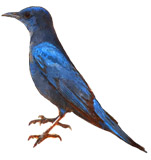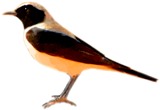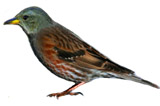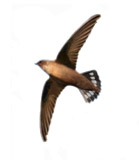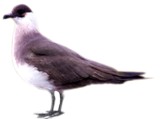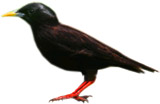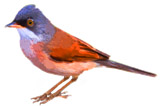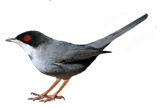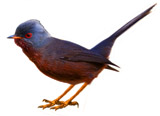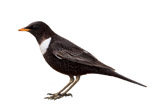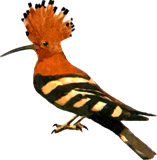HOTSPOT FACTSHEET: CAPE SAINT VINCENT
Location: Cape Saint Vincent; Vila do Bispo municipality, Western Algarve | Coordinates: 37º2’56.16”N, -8º58’0.35”W, (Lat/Long); 37.04893 N, -8.96676 W (decimal degrees) | Code: VB1 | Completion Time: up to 12-16 hours | Best Time for Birdwatching: September-December is the best period; spring migration is also worthwhile; all seasons offer good birding opportunities; however, July and August are the poorest months | Protection Status: Natural Park; Biogenetic Reserve; Important Bird Area (IBA); Special Protection Area & Special Area of Conservation (Natura 2000) | Activities: birding; nature walks; cycling, running & other outdoor activities; sightseeing; cultural travelling; boat trips to observe cetaceans, pelagic birds and other fauna; extreme sports;
[PLEASE CHECK CAPE ST. VINCENT’S BIRD SPECIALITIES AT THE BOTTOM OF THIS PAGE] A varied assortment of raptor, soaring, passerine and marine birds takes centre stage between late August and mid-November. Among birds of prey, the most frequent migrants are Booted Eagle, Sparrowhawk, Short-toed Snake-eagle, Common and Honey Buzzards, Kestrel and the rather impressive Griffon Vulture. However, the peninsula is also deservedly famous as a hotspot for threatened, vagrant, or rare species such as the Iberian Imperial Eagle (see also Cabranosa Birding Hotspot), and for noteworthy residents such as the Little Bustard and the Red-billed Chough. Provided the right optical equipment is utilized, Cape St. Vincent proper also offers excellent opportunities to observe a variety of seabirds. Depending on the season, Balearic and Cory’s Shearwaters, Northern Gannets, Scoters, Great and Pomarine Skuas, Parasitic Skuas, Razorbills and even (luck permitting) Grey Phalaropes can be relatively easy to identify from Cape St. Vincent.
Shearwaters are a regular sight; nonetheless, especially in the case of the Balearic species (Europe’s only critically endangered seabird), birds are more abundant through late September and early December. Together with the Straits of Gibraltar, Cape St. Vincent represents a bottleneck in their at-sea movements; as a consequence, Balearic Shearwaters are much easier to encounter around the Cape than in their far-northern range.
One other place where marine rarities make their appearance is Porto da Baleeira (please check the map above). Here, species like Ring-billed and Sabine’s Gulls have been spotted close to the town in the past; still, one of the best options to see those and other coastal and pelagic species up close is to embark on a specialized boat trip. The cliffs are also used by European Shags and – peculiarly – by White Storks as a base for their nests (that occurs mainly around Cabo Sardão, further north, and also in Praia do Vale dos Homens, for example).
Despite being less dramatic than the raptors’, the migration of passerines is also quite remarkable. Flying in low light, both trans-Saharan migrants and wintering passerines travel through the peninsula in their millions every single year. During broad daylight, most of these passerines take refuge in the many gorges and valleys scattered along the rugged coast. Typically, these nocturnal migrants are birds that live in abundant vegetation and that rarely venture out of it; they often include buntings, flycatchers, thrushes, cuckoos, and warblers that feed and rest through the day in order to build up the nutritional levels necessary to accomplish a long-distance flight during the night.
Indeed, at this time of the year, leafy valleys nourished by water streams (and rich in insects, like the ones near Bordeira) can be especially rewarding since many of them enclose a large amount of resting birds; however, trans-Saharan migrants tend to arrive earlier than wintering birds. From late August to early October, the peninsula is most often cruised by insect-eaters hoping to arrive in time for the insect proliferation that occurs in sub-Saharan Africa after the rainy season. They include both common species (like Yellow Wagtail, Whinchat, Redstart, and Pied Flycatcher) and more unusual ones (like Bluethroat or Western Bonelli’s Warbler). Please note that Tawny Pipit and Richard’s Pipit (as well as Hen Harrier and Marsh Harrier) are not very common around the cape – these species are more easily observed in Vale Santo or Cabranosa.
Grassland and abandoned farmland with scattered rocks, as well as young eucalyptus stands, are in turn occupied by the Black-eared Wheatear between late spring and September, the same month when small groups of shy Ortolan Buntings arrive at the Cape on their way to the Maghreb. These warier passerines are followed by dispersive and wintering species between October and November.
November marks the arrival of the Alpine Accentor and the Crag Martin, which join the Eurasian Jackdaw in the vicinity of the lighthouse (unfortunately, Jackdaws are not as abundant as they used to be, as the population decreased a lot). The highly mimetic but confident Alpine Accentors favour sheltered, out-of-the-way rock faces capped by thickets of shrubby vegetation; throughout the coastline, scree slopes, as well as juniper-covered cliff-tops and lusher gullies, are occupied by the beautiful Blue-rock Thrush, by Dartford Warblers, and by wintering Ring Ouzels (see also Castelejo Trail, below).
Naturally, if you are planning to follow the main birding itinerary, your visit should start early in the morning in order to take advantage both of the available time and of the most favourable light conditions. Concerning the observation of marine species, it is also worthwhile to change your location throughout the various promontories surrounding Cape St. Vincent. A suggestion is to start from the north-side headlands during the early hours and then explore the southern areas later on. Under fair weather circumstances those south-side locations may provide excellent views of a large number of seabirds, notably of Balearic Shearwaters during their post-breeding dispersive movements (from July onwards), and particularly between October and November, a period at the Cape when this endangered species actually seems far more abundant than it really is. One of the best places to observe marine birds is the small headland overlooking Mareta beach from the east; the spot is located between Sagres Point (where the Fortress stands) and Sagres proper. Bringing along a good telescope (preferably) and/or binoculars is of the utmost importance. You’ll need both a suitable wide-angle lens and a reasonable zoom. During autumn and winter, a strong maritime wind may blow throughout the peninsula: wearing warm clothes is therefore highly advisable.
Every year, on the first weekend of October, Sagres hosts its now famous Birdwatching Festival, which is the largest birdwatching event that takes place in Portugal. The festival’s program is very diverse and includes both individual and group activities such as field trips, ringing, boat trips, monitoring sessions, mini courses and environmental education workshops (plus much more). The festival also offers activities not directly related to birdwatching, like yoga, surfing, hiking, dolphin watching, cultural tours and horse or donkey riding. Some of these activities are free, while others offer sizable discounts for festival participants (children are welcome, of course), who will also be able to benefit from special prices on local accommodation, stores and restaurants.
Castelejo Trail: A short walking route through a densely forested gorge. The site is located west of Vila do Bispo on the way to Castelejo beach. Rare and endemic botanical species living in the Vicentine Coast Natural Park are here on floral display between January and May; the trail crosses distinct habitats, and there is a seasonal stream, as well as a medium-sized pond, that attract many passerine and some non-passerine species. The high cliffs and Mediterranean scrubland around Castelejo might provide good opportunities to observe a few notable birds during their spring and autumn migrations. Visitors can also enjoy the stunning views from the Castelejo and Torre de Aspa viewing points, as well as the significant geologic features at Telheiro Beach.
Carrapateira: A pretty headland with sombre escarpments and gorgeous coastal scenery. A bit away from the shoreline, visitors will also find a rural setting composed of sheltered valleys and hillsides with varied fauna and flora. Depending on the season, this is a good place to observe Pallid Swift, Red-rumped Swallow, Melodious, Subalpine and Sardinian Warblers, Iberian Chiffchaff, Firecrest, Crested Tit, Short-toed Treecreeper, Cirl and Rock Buntings and (sporadically) Bonelli’s Eagle. For further details, please see Carrapateira Trail.
Bordeira: Rich in resident birds like the Iberian Azure-winged Magpie and the Zitting Cisticola, the sheltered floodplains surrounding Bordeira are covered by a jigsaw of different habitats that also tend to attract many of the migrant passerines journeying across the Vicentine Coast. There, you’ll find the kind of thick vegetation favoured by many flycatchers, thrushes, orioles, cuckoos and warblers. Framed by a serene scenery, Bordeira has plenty of scrubland, grassland, farmland and healthy gallery forests to explore at length in a leisurely pace. For further details, please see Bordeira Trail.
Sagres Fortress: An historical fortress, purportedly the place from where Prince Henry the Navigator launched Europe’s maritime expansion (early 15th century) and the ensuing Age of Exploration. Today, besides being a bit run down, the Fortress has a few tacky architectural and overly touristic features; however, the endless views, the rugged overhanging cliffs, the seabirds, and the famous sunsets are well worth the trivial few euros for your admission. A visit requires a willingness to walk, since Sagres Point is a fairly large site.

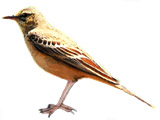
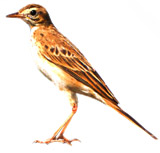
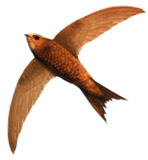
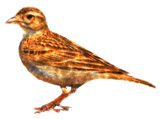

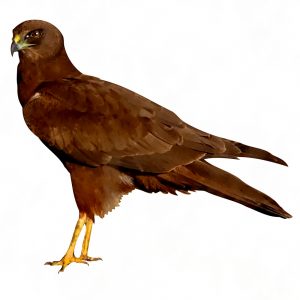 Circus aeruginosus
Circus aeruginosus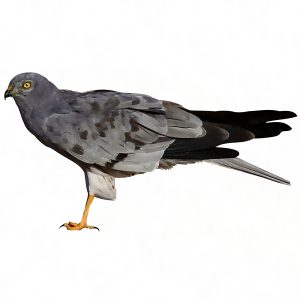 Circus pygargus
Circus pygargus